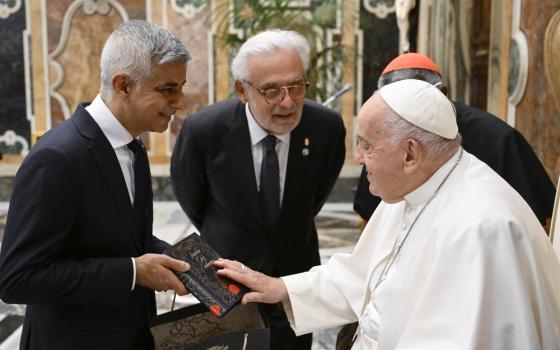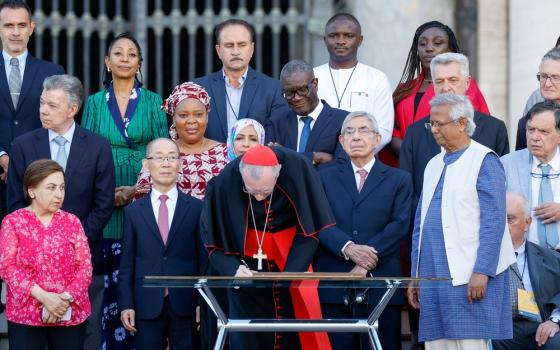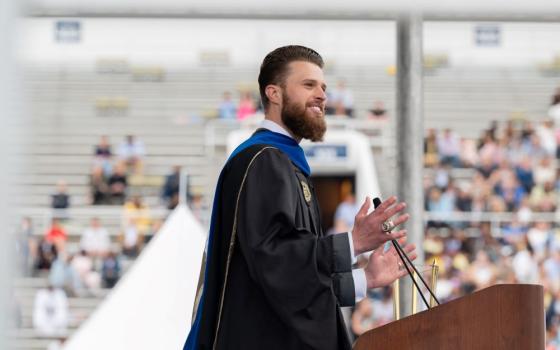WHEN THE WORLD CALLS: THE INSIDE STORY OF THE PEACE CORPS AND ITS FIRST FIFTY YEARS
By Stanley Meisler
Published by Beacon Press, $26.95
I knew just enough about the Peace Corps in the fall of 1987 that I attended this “Visiting Scholar” lecture on my own initiative (more typically I would have been there to fulfill a class requirement). Whatever Loret Miller Ruppe, then director of the Peace Corps, said when she spoke at Rockhurst College in Kansas City, Mo., that evening, she fired my enthusiasm. Greeting students afterwards, she told me that, as a junior, I was still too far away from graduation to apply just yet. But I picked up one of the little Peace Corps buttons she was giving away. I still have it.
Four years later, in October 1991 in Bangkok, Thailand, I was sworn in as a Peace Corps volunteer and headed off to serve as an English teacher in a rural northeast village.
I happily recognized Ruppe’s name when she popped up in Stanley Meisler’s When the World Calls: The Inside Story of the Peace Corps and Its First Fifty Years, and got a closer look at the director I had briefly met.
She had been an heiress who in 1981 had never worked full time for pay, and her appointment by the new Republican president, Ronald Reagan, initially dismayed the Peace Corps community. But she soon proved herself to be enthusiastic, energetic and fiercely protective of her agency. By the time she left in 1989 (still the longest-serving director), staff and current and former volunteers “acclaimed her as the most beloved and inspiring of all Peace Corps directors since Sargent Shriver,” Meisler writes.
Shriver himself came to Thailand in 1992 for a reception celebrating the 30th anniversary of the Peace Corps in that country. In an abstract kind of way, I appreciated the chance to meet the first director. Reading Meisler’s book made concrete to what degree Shriver forged what the Peace Corps would be.
When John F. Kennedy appointed his brother-in-law director, Meisler writes, the Peace Corps was “a name, a concept, and little more.” Shriver took Kennedy’s “lightly sketched” campaign promise and the executive order signed on March 1, 1961, and by August (50 years ago last month), had the first volunteers departing for their assignments. In the course of those “madcap” months, Shriver, along with his staff, established the essential structure of the agency that endures today -- including winning the crucial struggle to establish the Peace Corps’ autonomy from the Foreign Service and the U.S. Agency for International Development.
Three weeks after the first volunteers arrived in Ghana, Congress passed the Peace Corps Act, which enshrined the agency’s three goals. As stated on www.peacecorps.gov today, they are:
1) Helping the people of interested countries in meeting their need for trained men and women.
2) Helping promote a better understanding of Americans on the part of the peoples served.
3) Helping promote a better understanding of other peoples on the part of Americans.
Journalist Meisler himself worked for the Peace Corps in the 1960s as an evaluator, but When the World Calls is not all starry-eyed boosterism. There are disastrous missteps in the early years, often attributable to Shriver and company’s numbers obsession -- deploying more volunteers than host countries could, or should, accommodate. As the Vietnam War escalates, so does tension over volunteers’ rights to protest while abroad and under U.S. government employ. And over five decades Washington political machinations are a constant, from Nixon’s stealth efforts to kill the agency, to Peace Corps staff infighting, to tussles over what to name the headquarters or the agency itself, and ever-present budget battles.
Meisler’s book is weighted toward the ins and outs of Washington politics, and he draws the reader into these stories well enough that I’d find myself getting het up about major threats and minor squabbles of decades past. But there’s a reassuring continuity behind it all. As Meisler writes, “It was the individual experiences overseas that kept the Peace Corps going, whether the decisions in Washington were wise or foolish. That, in fact, was the genius of the Peace Corps idea: No matter what, the individual Volunteers always powered and ennobled the Peace Corps.”
 Whether my fellow volunteers and I were ennobling the Peace Corps or not, it was true in my experience that, aside from the occasional mention from Peace Corps staff (the Americans, not the Thais), we were removed from whatever was going on in Washington. The more relevant question to our lives as volunteers: What good are we doing? Is the Peace Corps worth it?
Whether my fellow volunteers and I were ennobling the Peace Corps or not, it was true in my experience that, aside from the occasional mention from Peace Corps staff (the Americans, not the Thais), we were removed from whatever was going on in Washington. The more relevant question to our lives as volunteers: What good are we doing? Is the Peace Corps worth it?
Meisler takes that question on as well. He gives a fair hearing to critics who say Peace Corps volunteers’ contribution to development is negligible, but it is clear where his sympathies lie. He acknowledges that volunteers will never be in large enough numbers to make an obvious impact, but lists a roll call of projects from the Peace Corps’ 2008 annual report, among them:
- Health education -- on HIV/AIDS, malaria, polio, tuberculosis and more -- in Burkina Faso;
- Four hundred computers donated for schools in El Salvador;
- Helping build or restore potable water systems in Honduras;
- Training 300 Kenyans in beekeeping as an income source.
The contributions of a teacher can be harder to quantify than other projects, and I wondered -- while I was a volunteer and in years after -- what good I did, teaching English to young teenagers, many of whom wouldn’t ever use it. But it was a required subject, and in the absence of someone who knew English, sometimes teachers whose expertise was in other subjects would have to teach it. When my volunteer time was ending, a friend and colleague wanted to know if the Peace Corps could send someone else. The answer, unfortunately, was no; it would be some other school’s turn.
But when I came back to visit in 2008, the school’s newest English teachers were both former students of mine: Usanee and Chatsuda. The latter, as a 13-year-old, used to come to my desk every day at lunchtime to ask me questions, with a group of friends giggling behind her, suggesting questions in Thai that they relied on her to form into English. I reminisced about those lunch chats when we met again in 2008, and she was surprised that I remembered -- but she was rather memorable.
Chatsuda told me she used to brag to her fellow college students that she had studied English with a native speaker, and when she was called upon to introduce me at a faculty meeting during my visit, she said I had inspired her to become an English teacher. It was my turn to be surprised, and grateful.
Meanwhile, Usanee and I have connected via Facebook and from there other former students have found me. They’re just a small fraction of the students who passed through my overcrowded classes. But it’s a treat to be able to rediscover and keep up that human connection that is foundational to the Peace Corps experience.
As Meisler notes, critics often fail to take into account that the Peace Corps’ goals don’t stop at that first one focused on development. To make the case for the other two, he quotes Sen. Chris Dodd, who served as a volunteer in the Dominican Republic, 1966-68: “Every American of goodwill we send abroad is another chance to make America known to a world that often fears and suspects us. And every American who returns from that service is a gift: a citizen who strengthens us with firsthand knowledge of the world.”
[NCR staff member Teresa Malcolm served as a Peace Corps volunteer in Thailand, 1991-93. Her e-mail address is tmalcolm@ncronline.org.]






